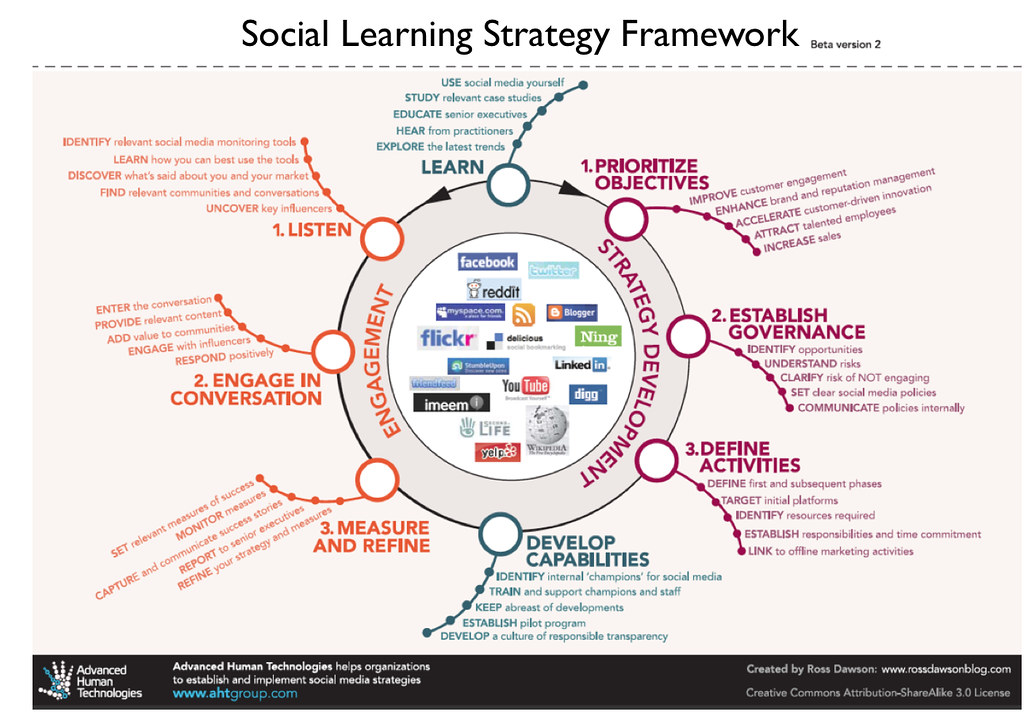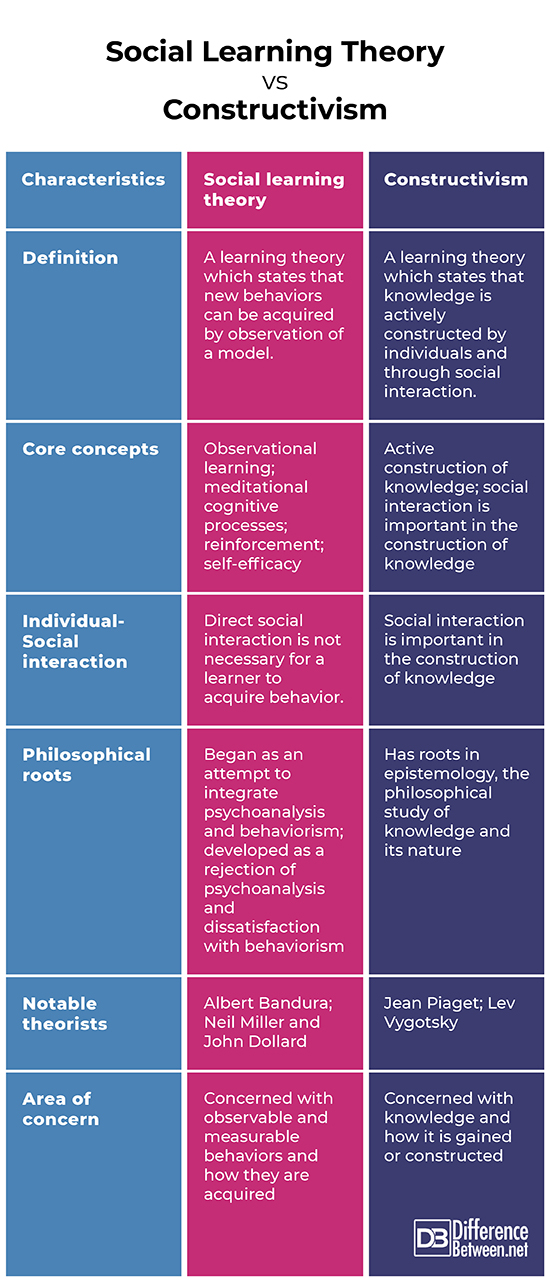Difference Between Social Learning Theory and Constructivism
Social learning theory and constructivism are two types of learning theories that are quite similar, at least on the surface. These two theories contend that learning has both an individual and a social aspect to it. Both consider the individual as an active part of the learning process and not just passively being shaped by stimuli and reinforcements, or just receiving information. Furthermore, both theories emphasize the role of social interaction in learning.
However, the two theories are quite very different from the start. Social learning theorists study how people acquire new behavior and so they are behaviorists in that sense. On the other hand, constructivists are mostly concerned with how people acquire or develop knowledge, that is, what and how people think. Aside from these, the two theories also differ in how they think the social environment facilitates or influences learning. More about social learning theory and constructivism are discussed and differentiated in the following sections.
What is Social Learning Theory?
At its simplest, the social learning theory states that learners acquire new behavior by observing others, typically an individual who the learner identifies with in some way, called a model. Of course, the theory adds, mostly through the work of Albert Bandura, that this modeling or observational learning is mediated both by the individual’s cognitive processes and by environmental factors. A learner has to be paying attention, able to retain the information (retention) as well as to act it out (production), and has motivation to go through the process. A concept carried over from the operant conditioning model of learning is reinforcement, although the reinforcement need not be direct. Social learning theorists believe that if an observed behavior came with a reward or punishment to the model, this affects how or whether the behavior is copied. In the process of observational learning, the model need not ever be in any form of contact with the learner. This is why Bandura emphasized the role of mass media. He expressed concern over the violence portrayed but also encouraged shows that can model prosocial behavior. In the later years of Bandura’s work on social learning theory, he added more concepts that emphasized the cognitive factors of his theory. He concluded that the behavior, the learner’s cognitive processes, and the environment are involved in a triadic reciprocal determinism, interacting with each other in the process of learning.
Social learning theory came about as an attempt to integrate, as well as a rejection of, psychoanalytic and behaviorist concepts into a learning theory. Neil Miller and John Dollard were one of the first in this tradition by reinterpreting drive theory within a stimulus-response model. They conceived a drive of imitation which can be reinforced by social interaction. Around the 1950’s, scientists began to either question or be dissatisfied with the principles of both psychoanalytic perspectives and behaviorism. Psychoanalysis was too concerned with concepts that are hard to observe and impossible to measure, such as the unconscious. Behaviorism did focus on observable and measurable behavior but could only explain automatic responses and acquired behavior. The cognitive revolution in psychology was also on the rise around this time, but Bandura was also not entirely convinced of the developmental models. He introduced instead the concept of self-efficacy, that learning can be seen as a function of the individual’s belief in his own capacity.
What is Constructivism?
Constructivism as a learning theory states that learners actively create or ‘construct’ their own knowledge. In addition, constructivists believe that knowledge is gained less by transmission from one person to another but mainly by teacher and learner working together, in a social interaction, to create or increase their knowledge. Although active construction of knowledge and social interaction are the two central ideas of most constructivist theories of learning, theorists do not agree in how much the two concepts are important in the process of learning. In fact, this has led to two main types of constructivism, psychological constructivism and social constructivism. Psychological constructivists focus on the inner psychological and mental processes of an individual, which is why this form of constructivism is also called individual or cognitive constructivism. Most of psychological constructivists agree learning happens in the mind as the learner constructs mental representations of perceived objects from the outside world. Well known in psychological constructivist theory is cognitive psychologist Jean Piaget who studied how individuals construct knowledge that cannot be gained by merely creating mental representations of external reality. Instead, Piaget focused on universal knowledge such as the concepts of conservation and reversibility, which can be gained by more complex cognitive processes such as reflection and logic.
The second form of constructivism, social constructivism, focuses on the shared construction of knowledge in a social interaction. By participating in social activities, everyone appropriates some form of knowledge from the results of the activity. Lev Vygotsky is considered as a social constructivist by many. He is famous for his concept of zone of proximal development – the area in which the learner can solve problems with a little bit of help from a teacher or mentor.
Constructivism as a whole is more a philosophy than a theory of learning. It traces its roots to epistemology, the branch of philosophy concerned with knowledge and its nature. Constructivists challenge traditional notions about knowledge. They claim, for example, that knowledge is more complex rather than simple, and is open to question rather than certainty.
Difference between Social Learning Theory and Constructivism
Definition
Social learning theory is a learning theory which states that behaviors can be acquired through observation of others. Constructivism, on the other hand, states that knowledge is actively constructed, either individually or socially.
Core Concepts
Social learning theory advances such concepts as observational learning, mediational cognitive processes, reinforcement and self-efficacy. Constructivism advances the concept of active construction of knowledge, and the importance of social interaction in the construction of knowledge.
Individual-Social Interaction
In social learning theory, there does not need to be a social interaction for a learner to acquire behaviors. In social constructivism at least, social interaction is important in the construction of knowledge.
Philosophical Roots
Social learning theory initially began as an attempt to integrate psychoanalytic and behaviorist principles, but developed as rejection of psychoanalysis and a dissatisfaction of the limitations of behaviorism. Constructivism’s roots are traced to epistemology, the branch of philosophy concerned with knowledge and its nature.
Notable Theorists
Notable in social learning theory is Albert Bandura, who has had the most contribution, and Neil Miller and John Dollard, who attempted to integrate the psychoanalytic drive theory and the behaviorist stimulus-response theory. Notable constructivists include Jean Piaget, known as the founder of constructivism, and Lev Vygotsky who focused on the importance of sociocultural learning.
Area of Concern
Social learning theory follows the behaviorist tradition of concerning itself with observable and measurable behaviors. Constructivism has a more cognitive influence as it concerns itself with knowledge.
Social Learning Theory vs Constructivism
Summary of Social Learning Theory vs Constructivism
- Social learning theory and constructivism are two perspectives on learning that take into consideration both individual and social aspects in the process of learning.
- Social learning theory states that learners can acquire new behaviors by observing a model that they identify with. Cognitive processes mediate observational learning, and is in a triadic reciprocal relationship with the behavior and the environment to facilitate learning.
- Constructivism states that learners actively construct their own knowledge and that social interaction is important in this process. Psychological constructivism emphasizes the individual’s cognitive processes in learning, while social constructivism emphasizes the social interaction.
- Difference Between Hematoma and Melanoma - February 9, 2023
- Difference Between Bruising and Necrosis - February 8, 2023
- Difference Between Brain Hematoma and Brain Hemorrhage - February 8, 2023
Search DifferenceBetween.net :
Leave a Response
References :
[0]Image credit: https://live.staticflickr.com/2636/3892775860_47832c5aa9_z.jpg
[1]Image credit: https://live.staticflickr.com/2505/3953558009_f1d2c7bae3_b.jpg
[2]Bandura, Albert. Social foundations of thought and action : A social cognitive theory. Englewood Cliffs, New Jersey: Prentice-Hall, 1986. Print.
[3]Salkind, Neil J. Encyclopedia of Educational Psychology. Thousand Oaks, CA: SAGE Publications Inc., 2008. Print.
[4]Woolfolk, Anita. Educational Psychology 13th Ed. England, UK: Pearson Education Limited, 2016. Print.



